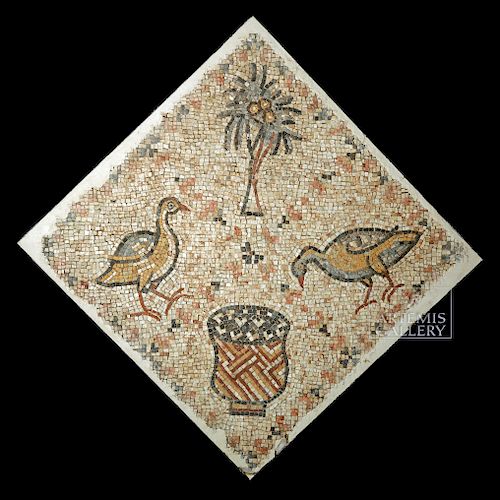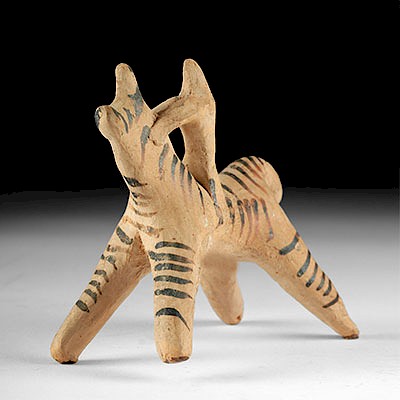Roman Mosaic w/ Birds, Urn, Palm for Victory & Peace
Lot 52a
About Seller
Artemis Fine Arts
686 S Taylor Ave, Ste 106
Louisville, CO 80027
United States
Selling antiquities, ancient and ethnographic art online since 1993, Artemis Gallery specializes in Classical Antiquities (Egyptian, Greek, Roman, Near Eastern), Asian, Pre-Columbian, African / Tribal / Oceanographic art. Our extensive inventory includes pottery, stone, metal, wood, glass and textil...Read more
Estimate:
$12,000 - $16,000
Absentee vs Live bid
Two ways to bid:
- Leave a max absentee bid and the platform will bid on your behalf up to your maximum bid during the live auction.
- Bid live during the auction and your bids will be submitted real-time to the auctioneer.
Bid Increments
| Price | Bid Increment |
|---|---|
| $0 | $25 |
| $300 | $50 |
| $1,000 | $100 |
| $2,000 | $250 |
| $5,000 | $500 |
| $10,000 | $1,000 |
| $20,000 | $2,500 |
| $50,000 | $5,000 |
| $100,000 | $10,000 |
| $200,000 | $20,000 |
About Auction
By Artemis Fine Arts
Oct 25, 2018
Set Reminder
2018-10-25 11:00:00
2018-10-25 11:00:00
America/New_York
Bidsquare
Bidsquare : Antiquities from Egypt, Greece, Italy, Asia
https://www.bidsquare.com/auctions/artemis-gallery/antiquities-from-egypt-greece-italy-asia-3538
Featuring Egyptian, Greek, Roman, Etruscan, Near Eastern, plus Asian art from Central and Far East. If you love the classics, this is the sale for you. Artemis Fine Arts info@artemisfinearts.com
Featuring Egyptian, Greek, Roman, Etruscan, Near Eastern, plus Asian art from Central and Far East. If you love the classics, this is the sale for you. Artemis Fine Arts info@artemisfinearts.com
- Lot Description
Late Roman or Early Byzantine, the Levant, late Imperial Period, ca. 4th to 6th century CE. A well-executed mosaic composition set on a diagonal that depicts two birds - perhaps ducks, doves, or quail - surrounding an elegant polychrome urn that is handsomely decorated with an attractive geometric/linear pattern. Above them is a fruitful palm tree. All is delineated in brick red, golden yellow ochre, charcoal black, slate grey, chocolate brown, and creamy beige square/rectangular stone tesserae. The birds are delineated in a naturalistic manner with great attention to detail, presenting our feathered friends' carefully delineated eyes, beaks, wings, plumage, perched feet, as well as distinct poses; note how the bird on the left is erect with the left foot raised as if about to move toward the vessel, while the bird on the right appears to be peering into the vase to inspect or peck at its contents. On the other hand, the palm tree above is rendered out of scale - not much larger than each bird - in a somewhat irrational manner that one finds in Roman Fourth Style wall paintings. Size: 53" W x 53" H (134.6 cm x 134.6 cm) oriented diagonally
Palm trees were especially significant in the ancient world - symbolizing peace, victory, and immortality. In ancient Rome the palm frond as well as the tree itself personified Victory. This meaning may be traced to ancient Greece where a palm branch was presented to the victors of athletic events. Furthermore, given that victory implies the end of a competition, rivalry, or conflict, the palm came to be a symbol of peace. Furthermore, in Mesopotamia and ancient Egypt, the palm signified immortality, and in Judaism, closed date palm fronds became a critical component of the lulav cherished during Sukkot to commemorate the years the Jewish people spent in the desert prior to reaching the Promised Land.
Birds - and indeed, animals of all kinds - were incredibly popular artistic themes in the Roman Empire. Romans delighted in seeing animals, and a major industry during the imperial period was the capture and transport of birds, mammals, and lizards for display and sport in the Roman arena. Ancient Roman mosaic artwork reflects this interest. For example, at Pompeii, there are multiple mosaics depicting well-rendered, lifelike birds engaging in a variety of activities - sitting in trees, warily watching cats, and in the case of one partridge, plucking at a necklace as if to steal it. Based on where mosaics depicting them have been found, birds seem to have been considered tranquil, peaceful subjects for the interiors of homes (not so the case with many other types of animals).
Mosaics (opus tesellatum) are some of our enduring images from the Roman world, not only for their aesthetic beauty, but also because they reveal what Romans chose to depict and see every day decorating their private and public spaces. This piece at first glance seems quite simple - two birds inspecting the contents of a vessel below a palm tree. However, the symbolism of the iconography is layered and rich. Perhaps this piece is commemorating a victory that recently occurred in a Roman arena - perhaps it is a statement of peace - perhaps a plea for longevity or eternal life. While impossible to know for certain, one can muse on these possibilities and certainly appreciate the immense skill and technique it took to create.
In the Roman province of Syria, which encompassed most of the ancient Near East/Levant, mosaics seem to have developed as a common art form relatively late, with most finds coming from the 3rd century CE or later. Syria was one of Rome's wealthiest provinces, but it was also far removed from Rome itself and Roman culture was overlaid on enduring cultural traditions from Hellenistic Greece and the great civilizations that came before it. For example, Antioch-on-the-Orontes (modern day Antakya, Turkey), was the capital of northern Roman Syria, and its excavations in the 1930s revealed more than three hundred mosaic pavements. This mosaic was probably in a private home.
Provenance: private East Coast, USA collection, acquired in the 1970s from the collection of Dr. Gary Karch, Florida, USA, purchased in Israel
All items legal to buy/sell under U.S. Statute covering cultural patrimony Code 2600, CHAPTER 14, and are guaranteed to be as described or your money back.
A Certificate of Authenticity will accompany all winning bids.
We ship worldwide and handle all shipping in-house for your convenience.
#138558Mounted in a modern cement matrix with a metal frame and board backing for added security. Small losses around edges and a few missing tesserae throughout, but the image is vivid and no detail is lost. Otherwise in very nice condition with light encrustation in between the tesserae. Inventory label that reads "Lot No. CFO271 / 010 Classic F.A." and another small white collection label with the number 5738 on one side of metal framing.Condition
- Shipping Info
-
All shipping is handled in-house for your convenience. Your invoice from Artemis Gallery will include shipping calculation instructions. If in doubt, please inquire BEFORE bidding for estimated shipping costs for individual items.
-
- Buyer's Premium



 EUR
EUR CAD
CAD AUD
AUD GBP
GBP MXN
MXN HKD
HKD CNY
CNY MYR
MYR SEK
SEK SGD
SGD CHF
CHF THB
THB













